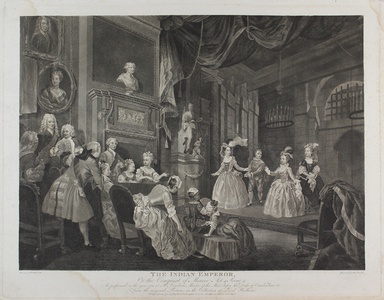| Method | Etching and aquatint |
| Artist | Robert Dodd after William Hogarth |
| Published | Painted by Wm. Hogarth. Engrav'd by Robt. Dodd. Publish'd Jan.y 1 1792, by J. & J. Boydell, Cheapside, & at the Shakspeare Gallery Pall Mall. |
| Dimensions | Image & Sheet 405 x 540 mm |
| Notes |
An etching by Robert Dodd after an original oil painting of 'The Indian Emperor' by William Hogarth, commissioned by John and Josiah Boydell for their editions of Hogarth's collected works. The Boydell edition of 1803 list Dodd's etching as the companion to the famous and celebrated engraving of 'The Beggar's Opera' by William Blake. The painting was commissioned by John Conduitt, Master of the Mint, in commemoration of a children's production of Dryden's play 'The Indian Empereur, or, the Conquest of Mexico by the Spaniards.' The key to the painting provided by Boydell lists a number of prominent figures, including the young Duke of Cumberland, Princesses Mary and Louisa, Lady Caroline Lennox, and the young Duke of Leinster (in the performance at centre). The etching depicts Act 4, Scene 4, in which Almeria and Cydaria fight for Cortez' love in a Prison. Inscription below title reads: As performed in the year 1731 at Mr. Conduit's, Master of the Mint, before the Duke of Cumberland etc. From the original Picture in the Collection of Lord Holland. Robert Dodd (1748 - 1815) was a British etcher and aquatint engraver. Although he etched a stage-scene of the 'Indian Emperor' after a painting by William Hogarth, he is predominantly known as a landscape artist. His particular speciality was maritime scenes, as shown by a number of aquatints of ships and maritime battles from the French Revolutionary Wars. His most famous work depicts the infamous 'Mutiny on the Bounty,' with Captain Bligh and the loyal crew set adrift in a lifeboat by the mutineers. William Hogarth (1697 - 1764) was born in London, the son of an unsuccessful schoolmaster and writer from Westmoreland. After apprenticeship to a goldsmith, he began to produce his own engraved designs in about 1710. He later took up oil painting, starting with small portrait groups called conversation pieces. He went on to create a series of paintings satirising contemporary customs, but based on earlier Italian prints, of which the first was The Harlot's Progress (1731), and perhaps the most famous The Rake's Progress. His engravings were so plagiarised that he lobbied for the Copyright Act of 1735, commonly referred to as 'Hogarth's Act,' as a protection for writers and artists. During the 1730s Hogarth also developed into an original painter of life-sized portraits, and created the first of several history paintings in the grand manner. Condition: Trimmed close to platemark at top and bottom, as issued. Waterstains and foxing to margins, into plate at corners. |
| Framing | unmounted |
| Price | £200.00 |
| Stock ID | 50661 |

